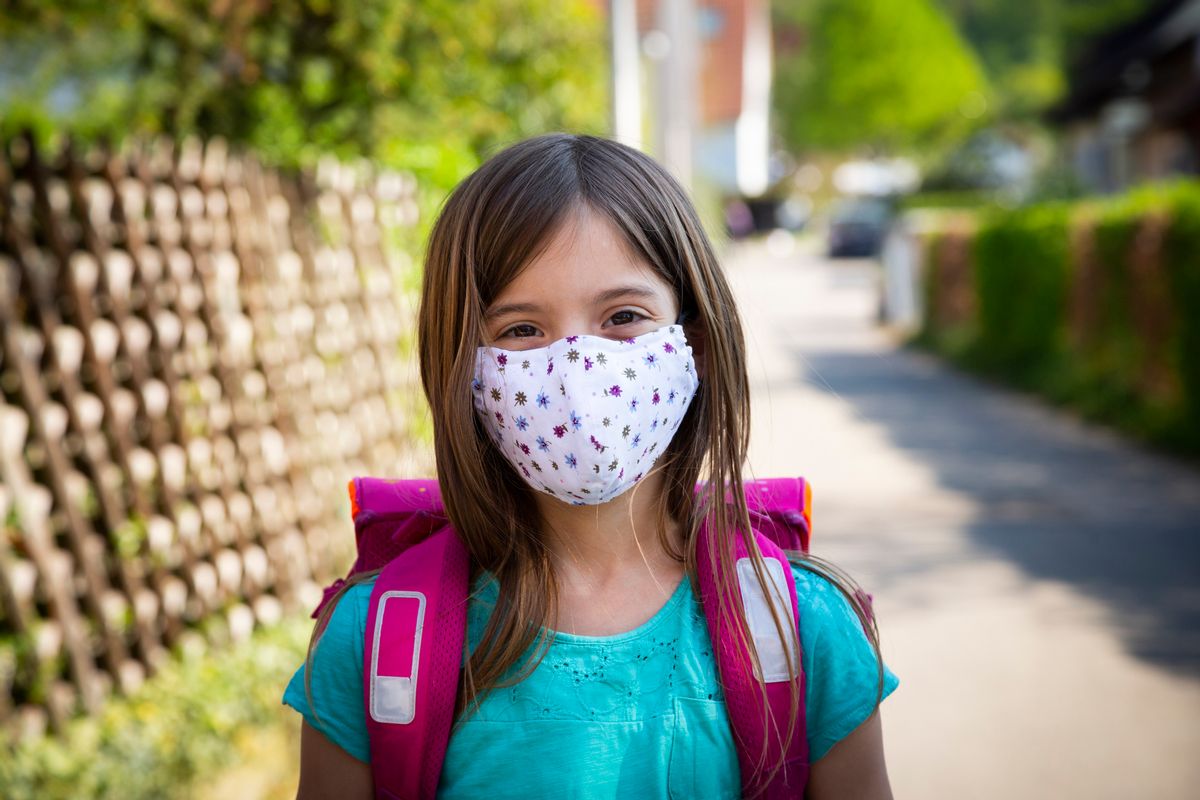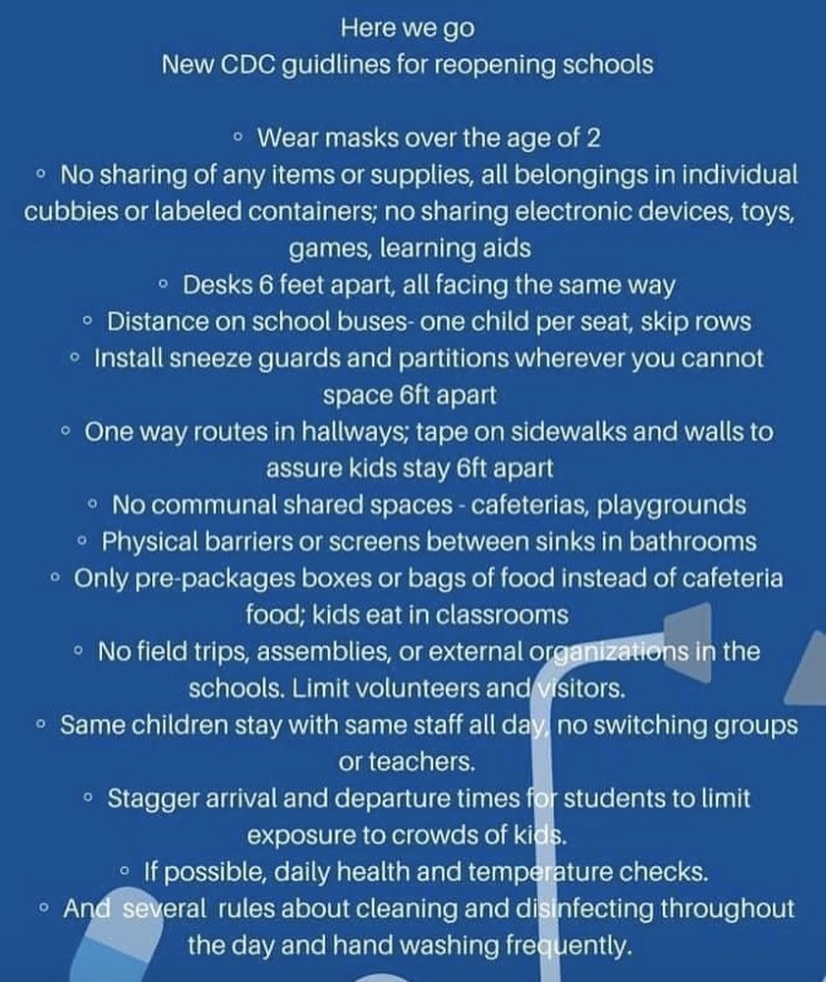The CDC published a set of guidelines that schools can adopt when feasible as they consider reopening amid the COVID-19 coronavirus pandemic.
The guidelines are not mandatory, and they are not meant to be uniformly applied to all schools nationwide. Schools are encouraged to abide by state and local health mandates and apply any recommendations that make sense to them to keep students and staff members safe.
In late May 2020, social media users circulated a graphic purportedly containing recommendations from the U.S. Centers for Disease Control and Prevention (CDC) for reopening schools amid the COVID-19 coronavirus pandemic. The graphic, containing a blue background and the words "Here we go," went viral on Facebook. A slightly different version of the graphic was posted on the blog KidsActivities.com.
The stringent list prompted some anxiety, and readers asked Snopes.com to verify whether it was real. Below is a screenshot of it circulating on Facebook:
Although the text on the graphic is drawn from CDC guidance for school re-openings that was issued on May 19, 2020, the CDC did not produce the graphic. The actual wording of the CDC guidance is couched a bit more gently and notes that the precautions should only be taken into consideration and implemented to the extent feasible for schools. In other words, the recommendations are not mandatory:
As some communities in the United States open K-12 schools, CDC offers the following considerations for ways in which schools can help protect students, teachers, administrators, and staff and slow the spread of COVID-19. Schools can determine, in collaboration with state and local health officials to the extent possible, whether and how to implement these considerations while adjusting to meet the unique needs and circumstances of the local community. Implementation should be guided by what is feasible, practical, acceptable, and tailored to the needs of each community. School-based health facilities may refer to CDC’s Guidance for U.S. Healthcare Facilities and may find it helpful to reference the Ten Ways Healthcare Systems Can Operate Effectively During the COVID-19 Pandemic. These considerations are meant to supplement — not replace — any state, local, territorial, or tribal health and safety laws, rules, and regulations with which schools must comply.
Below, we compare what the graphic states (we combined some of the similar bulleted items) and what the CDC guidelines say verbatim and in context:
'Wear masks over the age of 2'
Under the heading, "Promoting Behaviors that Reduce Spread," the CDC notes that "Schools may consider implementing several strategies to encourage behaviors that reduce the spread of COVID-19." Those behaviors include staying home when one feels sick or has had contact with someone diagnosed with COVID-19, washing hands regularly for at least 20 seconds, and using cloth face coverings, which are meant to protect others in the event that the wearer unknowingly has COVID-19. Under the bullet point "Cloth Face Coverings," the CDC states:
Teach and reinforce use of cloth face coverings. Face coverings may be challenging for students (especially younger students) to wear in all-day settings such as school. Face coverings should be worn by staff and students (particularly older students) as feasible, and are most essential in times when physical distancing is difficult. Individuals should be frequently reminded not to touch the face covering and to wash their hands frequently. Information should be provided to staff, students, and students’ families on proper use, removal, and washing of cloth face coverings.
The CDC directs that cloth face masks should not be placed on children under the age of 2, along with anyone who is incapacitated and can't remove it without help or anyone who has trouble breathing.
'No sharing of any items or supplies, all belongings in individual cubbies or labeled containers, no sharing electronic devices, toys, games learning aids'
The CDC states that school children should avoid sharing each other's items:
- Discourage sharing of items that are difficult to clean or disinfect.
- Keep each child’s belongings separated from others’ and in individually labeled containers, cubbies, or areas.
- Ensure adequate supplies to minimize sharing of high touch materials to the extent possible (e.g., assigning each student their own art supplies, equipment) or limit use of supplies and equipment by one group of children at a time and clean and disinfect between use.
- Avoid sharing electronic devices, toys, books, and other games or learning aids.
'Desks six feet apart, all facing the same way' and 'Distance on school buses — one child per seat, skip rows'
The CDC recommends modified layouts in classrooms and spaced seating in school buses:
- Space seating/desks at least 6 feet apart when feasible.
- Turn desks to face in the same direction (rather than facing each other), or have students sit on only one side of tables, spaced apart.
- Create distance between children on school buses (g., seat children one child per row, skip rows) when possible.
'Install sneeze guards and partitions whenever you cannot space 6 ft apart' and 'One way routes in hallways, tape on sidewalks and walls to ensure kids stay 6 ft apart'
The CDC recommends partitions be installed along with tape markers to guide people to remain a safe distance apart:
- Install physical barriers, such as sneeze guards and partitions, particularly in areas where it is difficult for individuals to remain at least 6 feet apart (e.g., reception desks).
- Provide physical guides, such as tape on floors or sidewalks and signs on walls, to ensure that staff and children remain at least 6 feet apart in lines and at other times (e.g. guides for creating “one way routes” in hallways).
'No communal shared spaces — cafeterias, playgrounds' and 'Physical barriers or screens between sinks in bathrooms'
The CDC recommends that communal spaces be closed if possible, or that use be staggered and the area be cleaned between use:
- Close communal use shared spaces such as dining halls and playgrounds with shared playground equipment if possible; otherwise, stagger use and clean and disinfect between use.
- Add physical barriers, such as plastic flexible screens, between bathroom sinks especially when they cannot be at least 6 feet apart.
'Only pre-packaged boxes or bags of food instead of cafeteria food; kids eat in classrooms'
The CDC recommends that children bring their own food if feasible and, if not, that children be served individual, pre-packaged meals.
- Have children bring their own meals as feasible, or serve individually plated meals in classrooms instead of in a communal dining hall or cafeteria, while ensuring the safety of children with food allergies.
- Use disposable food service items (e.g., utensils, dishes). If disposable items are not feasible or desirable, ensure that all non-disposable food service items are handled with gloves and washed with dish soap and hot water or in a dishwasher. Individuals should wash their hands after removing their gloves or after directly handling used food service items.
- If food is offered at any event, have pre-packaged boxes or bags for each attendee instead of a buffet or family-style meal. Avoid sharing food and utensils and ensure the safety of children with food allergies.
'No field trips, assemblies, or external organizations in the schools. Limit volunteers and visitors'
The CDC recommends pursuing virtual learning events in lieu of physical fields trips and limiting non-essential visitors to campuses:
- Pursue virtual group events, gatherings, or meetings, if possible, and promote social distancing of at least 6 feet between people if events are held. Limit group size to the extent possible.
- Limit any nonessential visitors, volunteers, and activities involving external groups or organizations as possible – especially with individuals who are not from the local geographic area (e.g., community, town, city, county).
- Pursue virtual activities and events in lieu of field trips, student assemblies, special performances, school-wide parent meetings, and spirit nights, as possible.
- Pursue options to convene sporting events and participation in sports activities in ways that minimizes the risk of transmission of COVID-19 to players, families, coaches, and communities.
'Same children stay with same staff all day, no switching groups or teachers'
The CDC recommends putting students and staff in "cohorts" and limiting them to small cohorts to the extent possible:
- Ensure that student and staff groupings are as static as possible by having the same group of children stay with the same staff (all day for young children, and as much as possible for older children).
- Limit mixing between groups if possible.
'Stagger arrival and departure times for students to limit exposure to crowds of kids'
The CDC recommends policies that allow for staggered schedules or telework to allow for social distancing, but defers to state and local health care authorities:
- Stagger arrival and drop-off times or locations by cohort or put in place other protocols to limit contact between cohorts and direct contact with parents as much as possible.
- When possible, use flexible worksites (e.g., telework) and flexible work hours (e.g., staggered shifts) to help establish policies and practices for social distancing (maintaining distance of approximately 6 feet) between employees and others, especially if social distancing is recommended by state and local health authorities.
'If possible, daily health and temperature checks'
The CDC recommends daily health screenings, i.e., temperature and symptom checks, "if feasible."
'And several rules about cleaning and disinfecting throughout the day and hand washing frequently'
Although it's true the CDC's guidelines contain several pointers about personal hygiene and disinfecting common-use areas, none is a "rule." As we noted above, the CDC's guidance states that the recommendations can be implemented on a voluntary basis and only when feasible. They are not nationwide mandates for reopening schools. Overall, the CDC recommends school administrators to obey state and local authorities and assess their schools' abilities to protect staff and children from contracting the disease, but these recommendations are not mandatory.
Because the bullet points in the graphic did accurately represent recommendations laid out by the CDC guidance issued on May 19, but led some to falsely believe they were mandatory and meant to be applied uniformly everywhere, we rate the veracity of this claim as "Mixture."


